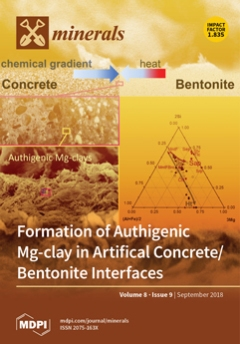Seawater has been considered as an alternative to freshwater for flotation. However, many ions in seawater were reported to depress molybdenite (MoS
2), with the depressing mechanisms being insufficiently understood. In this study, the influence of divalent ions (e.g., Ca
2+ and
[...] Read more.
Seawater has been considered as an alternative to freshwater for flotation. However, many ions in seawater were reported to depress molybdenite (MoS
2), with the depressing mechanisms being insufficiently understood. In this study, the influence of divalent ions (e.g., Ca
2+ and Mg
2+) and dispersant on MoS
2 flotation was systematically investigated. It was found that the detrimental effects of Ca
2+ and Mg
2+ on the natural flotability of MoS
2 were mainly due to the attachment of formed CaMoO
4 precipitates and Mg(OH)
2 colloids onto MoS
2 surface. However, the addition of sodium hexametaphosphate (SHMP) reduced the negative effects. Various measurements, including contact angle, zeta potential, fourier transform infrared spectroscopy (FTIR), X-ray photoelectron spectroscopy (XPS) and atomic force microscope (AFM), were conducted to understand the influencing mechanisms of divalent ions and the beneficial effects of SHMP on MoS
2 flotation. In addition, the Extended Derjguin–Landau–Verwey–Overbeek (EDLVO) theory was applied to investigate the total interaction energy between MoS
2 particles and formed colloids, revealing that the reduced attraction force between MoS
2 and Mg(OH)
2 colloids in the presence of SHMP primarily resulted in the increased MoS
2 recovery. In addition, SHMP combined with Mg
2+ and Ca
2+ to form dissolvable complexes, thereby reducing insoluble Mg
2+ and Ca
2+ compounds or precipitation. Thus, this study demonstrated for the first time two influencing mechanisms of SHMP in improving MoS
2 recovery in the presence of Ca
2+ and Mg
2+.
Full article





